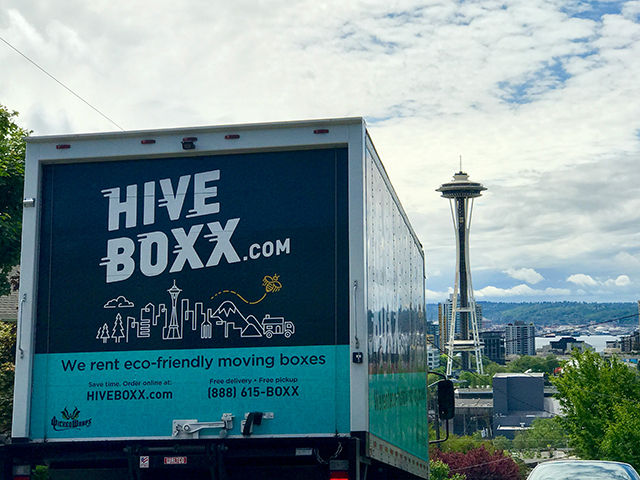In today’s fast-paced world, delivery service businesses are booming. From food couriers to parcel logistics, the sight of a branded delivery vehicle is now part of our everyday lives. But here’s the thing — many delivery businesses are missing a huge marketing opportunity by not optimizing their vehicle signage.
Vehicle signage isn’t just about slapping a logo on the side of a van and calling it a day. It’s a mobile billboard that advertises your brand wherever your vehicle goes. To get the most out of it, you need to be smart about what you display and where you place it. This guide walks you through exactly how to do that, with a special focus on delivery businesses using stickers for vehicle branding.
Why Vehicle Signage Matters for Delivery Services
When you run a delivery business, your vehicle is on the road more than most. It’s parking in driveways, pulling up to homes, navigating business districts, and stopping in public areas where thousands of eyes can spot it. This constant visibility means free advertising — but only if your signage is eye-catching, legible, and professionally placed.
Proper placement not only enhances brand recognition but also makes your business look legitimate and trustworthy. It can even boost customer confidence when your driver shows up at a doorstep in a professionally branded vehicle.
First Things First: What Do You Need?
Before diving into placement, here’s a checklist of what you’ll need for effective signage application:
- High-quality vinyl stickers for vehicle use
- Your brand’s logo, tagline, and contact details
- A clean and dry surface on the vehicle
- Measurement tools (tape measure, level, masking tape)
- Squeegee or plastic card for smooth application
- Optional: A professional installer (recommended for full wraps or large decals)
Now that your tools are in order, let’s get into where and how to place your signage for maximum impact.
Top 5 Signage Zones for Delivery Vehicles
Each part of your vehicle serves a purpose — visually and functionally. Here are the prime locations you should focus on, and why:
1. Driver and Passenger Side Doors
Why it works:
This is a no-brainer. Side doors are the most visible parts of your vehicle in traffic and when parked curbside. Since your vehicle will often be seen from the side — either in driveways or on the road — this is where your logo and business name should go first.
What to place:
- Business logo
- Company name
- Optional: Phone number or website
- QR code for app-based orders (bonus tip)
Placement tip:
Center the decal horizontally on the door panel. Use masking tape to pre-position the sticker for vehicle alignment and make sure it’s perfectly straight.
2. Rear Windows or Tailgate
Why it works:
When you’re stuck in traffic or parked in a busy lot, the back of your vehicle gets the most eyes. This is your chance to leave a lasting impression.
What to place:
- Slogan or tagline
- Website URL or phone number
- Social media handles (if readable)
Placement tip:
Use perforated window film if applying to glass, so the driver still has visibility. Position your info high enough to avoid it being blocked by license plates or bumpers.
3. Rear Quarter Panels
Why it works:
This often-overlooked area near the back wheel is surprisingly effective for secondary messaging — especially when your vehicle is parked side-on.
What to place:
- Service offering (“Fast food delivery,” “Express couriers,” etc.)
- Coverage area (“Serving Sydney metro,” etc.)
- Business hours or response time
Placement tip:
Keep the messaging concise and bold. Use simple fonts and contrasting colors so it’s readable at a glance.
4. Front Bonnet (Hood)
Why it works:
While not as visible on the move, the hood can stand out when parked nose-out in driveways or lots. It’s ideal for reinforcing branding.
What to place:
- Just the logo, clean and centered
- Optional: Tagline in smaller text beneath
Placement tip:
Use symmetrical placement to center the design. Avoid cluttering this space — it should complement, not compete, with side or rear signage.
5. Roof (Optional, but Clever)
Why it works:
If your delivery vehicle operates in areas with tall buildings, like city centers or apartment blocks, a rooftop sign is genius. Pedestrians and people looking out of windows can see your brand even when the car is parked below.
What to place:
- Brand logo
- Delivery icon or “On Delivery” message
Placement tip:
This can be a decal or a 3D magnetic rooftop sign (like those used by pizza delivery vehicles).
Design Do’s and Don’ts
Do:
- Use large, bold fonts
- Stick to 2–3 colors that contrast with your vehicle
- Include your website or a phone number
- Keep it simple: one clear message per zone
- Use UV and weather-resistant stickers for vehicle durability
Don’t:
- Overcrowd your design
- Use fancy fonts that are hard to read
- Forget to clean and prep the surface first
- Place text over curves or handles that distort it
- Ignore local signage regulations (check your area)
DIY vs. Professional Installation
For small decals, a DIY approach using quality stickers for vehicle is perfectly acceptable. But for large wraps or more complex applications, hiring a professional ensures longevity and a polished look.
Pros will also know how to apply decals without air bubbles, handle curves properly, and use the right materials for your climate (especially important in hot or rainy areas).
Maintaining Your Signage
- Wash regularly with a mild detergent
- Avoid pressure washing the edges of your decals
- Inspect for peeling or fading every few months
- Replace damaged signage to maintain a professional image
Final Thoughts: Mobile Marketing That Works While You Work
Your delivery vehicle isn’t just a tool — it’s a moving advertisement that can generate leads every time it hits the road. Strategic placement of your stickers for vehicle branding can turn every traffic jam, customer delivery, or petrol stop into a marketing opportunity.
By following this guide and placing your signage in the right locations, you’ll boost your brand’s visibility, appear more professional to clients, and make the most of every kilometer your business covers.
So stick it right — and let your vehicle do the talking. Use this weblink to access our website and look for our car stickers that we have made.

